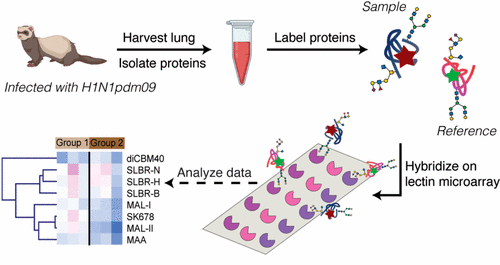当前位置:
X-MOL 学术
›
J. Proteome Res.
›
论文详情
Our official English website, www.x-mol.net, welcomes your feedback! (Note: you will need to create a separate account there.)
Age-Dependent Glycomic Response to the 2009 Pandemic H1N1 Influenza Virus and Its Association with Disease Severity
Journal of Proteome Research ( IF 4.4 ) Pub Date : 2020-09-27 , DOI: 10.1021/acs.jproteome.0c00455 Shuhui Chen 1 , Brian Kasper 1 , Bin Zhang 2 , Lauren P Lashua 3 , Ted M Ross 4 , Elodie Ghedin 3, 5 , Lara K Mahal 1, 6
Journal of Proteome Research ( IF 4.4 ) Pub Date : 2020-09-27 , DOI: 10.1021/acs.jproteome.0c00455 Shuhui Chen 1 , Brian Kasper 1 , Bin Zhang 2 , Lauren P Lashua 3 , Ted M Ross 4 , Elodie Ghedin 3, 5 , Lara K Mahal 1, 6
Affiliation

|
Influenza A viruses cause a spectrum of responses, from mild coldlike symptoms to severe respiratory illness and death. Intrinsic host factors, such as age, can influence disease severity. Glycosylation plays a critical role in influenza pathogenesis; however, the molecular drivers of influenza outcomes remain unknown. In this work, we characterized the host glycomic response to the H1N1 2009 pandemic influenza A virus (H1N1pdm09) as a function of age-dependent severity in a ferret model. Using our dual-color lectin microarray technology, we examined baseline glycosylation and glycomic response to infection in newly weaned and aged animals, models for young children and the elderly, respectively. Compared to adult uninfected ferrets, we observed higher levels of α-2,6-sialosides, the receptor for H1N1pdm09, in newly weaned and aged animals. We also observed age-dependent loss of O-linked α-2,3-sialosides. The loss of these highly charged groups may impact viral clearance by mucins, which corresponds to the lower clearance rates observed in aged animals. Upon infection, we observed dramatic changes in the glycomes of aged animals, a population severely impacted by the virus. In contrast, no significant alterations were observed in the newly weaned animals, which show mild to moderate responses to the H1N1pdm09. High mannose, a glycan recently identified as a marker of severity in adult animals, increased with severity in the aged population. However, the response was delayed, in line with the delayed development of pneumonia observed. Overall, our results may help explain the differential susceptibility to influenza A infection and severity observed as a function of age.
中文翻译:

对 2009 年 H1N1 流感病毒大流行的年龄依赖性糖组反应及其与疾病严重程度的关系
甲型流感病毒会引起一系列反应,从轻微的感冒症状到严重的呼吸道疾病和死亡。内在的宿主因素,例如年龄,可以影响疾病的严重程度。糖基化在流感发病机制中发挥着关键作用;然而,流感结果的分子驱动因素仍然未知。在这项工作中,我们在雪貂模型中将宿主对 H1N1 2009 大流行甲型流感病毒 (H1N1pdm09) 的糖组反应描述为年龄依赖性严重程度的函数。使用我们的双色凝集素微阵列技术,我们分别检查了新断奶和老年动物、幼儿模型和老年人模型对感染的基线糖基化和糖组反应。与成年未感染的雪貂相比,我们在刚断奶和老年的动物中观察到更高水平的 α-2,6-唾液酸苷(H1N1pdm09 的受体)。我们还观察到 O-连接 α-2,3-唾液酸苷的年龄依赖性损失。这些高电荷基团的丢失可能会影响粘蛋白的病毒清除率,这与在老年动物中观察到的较低清除率相对应。感染后,我们观察到老年动物的糖组发生了巨大变化,这些动物受到病毒的严重影响。相比之下,新断奶的动物没有观察到显着的变化,它们对 H1N1pdm09 表现出轻度至中度的反应。高甘露糖是一种最近被确定为成年动物严重程度标志物的聚糖,随着老年人口的严重程度的增加,高甘露糖含量也随之增加。然而,反应被延迟,这与观察到的肺炎的延迟发展一致。总的来说,我们的结果可能有助于解释甲型流感感染的不同易感性和观察到的严重程度随年龄的变化。
更新日期:2020-11-06
中文翻译:

对 2009 年 H1N1 流感病毒大流行的年龄依赖性糖组反应及其与疾病严重程度的关系
甲型流感病毒会引起一系列反应,从轻微的感冒症状到严重的呼吸道疾病和死亡。内在的宿主因素,例如年龄,可以影响疾病的严重程度。糖基化在流感发病机制中发挥着关键作用;然而,流感结果的分子驱动因素仍然未知。在这项工作中,我们在雪貂模型中将宿主对 H1N1 2009 大流行甲型流感病毒 (H1N1pdm09) 的糖组反应描述为年龄依赖性严重程度的函数。使用我们的双色凝集素微阵列技术,我们分别检查了新断奶和老年动物、幼儿模型和老年人模型对感染的基线糖基化和糖组反应。与成年未感染的雪貂相比,我们在刚断奶和老年的动物中观察到更高水平的 α-2,6-唾液酸苷(H1N1pdm09 的受体)。我们还观察到 O-连接 α-2,3-唾液酸苷的年龄依赖性损失。这些高电荷基团的丢失可能会影响粘蛋白的病毒清除率,这与在老年动物中观察到的较低清除率相对应。感染后,我们观察到老年动物的糖组发生了巨大变化,这些动物受到病毒的严重影响。相比之下,新断奶的动物没有观察到显着的变化,它们对 H1N1pdm09 表现出轻度至中度的反应。高甘露糖是一种最近被确定为成年动物严重程度标志物的聚糖,随着老年人口的严重程度的增加,高甘露糖含量也随之增加。然而,反应被延迟,这与观察到的肺炎的延迟发展一致。总的来说,我们的结果可能有助于解释甲型流感感染的不同易感性和观察到的严重程度随年龄的变化。


























 京公网安备 11010802027423号
京公网安备 11010802027423号